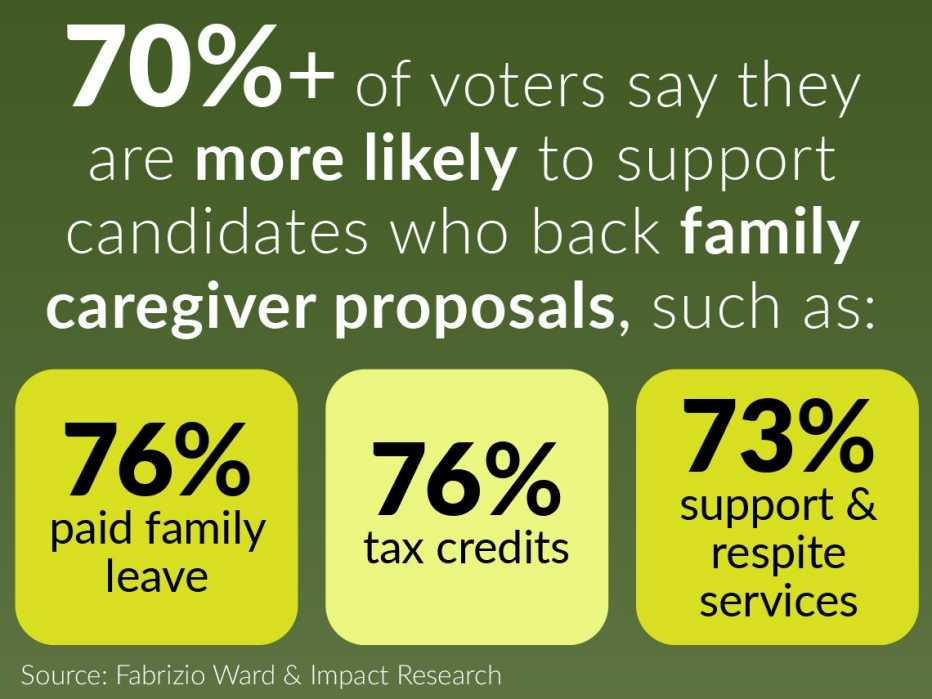Staying Fit


Heads up, Congress: A new AARP poll finds that when voters 50 and older gear up for future elections, how candidates address their concerns about key family caregiving issues will greatly influence their vote.
The survey found that a majority of voters — 70 percent — say they are more likely to support a candidate who backs proposals to support family caregivers, such as tax credits, paid family leave and respite services. An overwhelming 75 percent of voters 50-plus want to be able to stay in their homes as they age, and say it is important for Congress to help older Americans live independently in their homes instead of in a nursing facility. These concerns are expressed in similar numbers among Democrats and Republicans.


AARP Membership— $12 for your first year when you sign up for Automatic Renewal
Get instant access to members-only products and hundreds of discounts, a free second membership, and a subscription to AARP the Magazine.
“Family caregivers are the backbone of a broken long-term care system, providing $600 billion in unpaid labor each year and saving taxpayers billions,” says Nancy LeaMond, AARP executive vice president and chief advocacy and engagement officer. “It is long past time for lawmakers to enact commonsense solutions that support family caregivers and help older Americans live independently in their homes, where they want to be.”
The AARP poll was conducted by a bipartisan team of pollsters who surveyed 1,425 registered voters, with oversamples of voters age 50+, Black voters, Latino voters, Asian American/Pacific Islander voters and family caregivers. The survey was conducted by phone and text-to-web from April 4-10, 2023, and has a margin of error of plus or minus 3.4 percentage points.
“It’s no surprise that voters prioritize issues that have played big roles in recent elections and will again in 2024, like protecting social security and Medicare and lowering prescription drug prices,” says Matt Hogan, Democratic pollster and partner at Impact Research. Hogan conducted the poll along with Bob Ward, a GOP pollster and partner at Fabrizio Ward. “What may come as surprise to many is that voters prioritize helping seniors live independently at home and supporting family caregivers at a level higher than some issues that tend to command more of the media spotlight, such as investing in clean energy and student loan debt.”


Ward says the reason why is simple: “More than three-quarters of voters are either currently, have been, or expect to be a caregiver for an aging loved one. There is a real opportunity for candidate on both sides of the aisle to feature home care and family caregiver support in their campaigns and get the upper hand on these high-priority issues.”
The over 45 million voters who provide unpaid care to an aging, sick or disabled loved one or friend are an important constituency and they want their voices heard. While for many the work is a labor of love — 40 percent spend more than 20 hours a week assisting with everything from driving a family member or friend to appointments to managing medical claims to providing hands-on assistance — it comes with much pressure. The majority of caregivers surveyed say they are stretched thin emotionally (72 percent) and financially (55 percent), with 60 percent saying they are “overwhelmed” by the additional responsibility.




































































More From AARP
Why Family Caregivers Should Say “No”
Occasionally declining help can assist the care recipient in the long run
Hate Waiting? How Family Caregivers Can Limit Medical Office Delays
Planning and a little assertiveness are the keys to winning the waiting game
10 Tips for Splitting Caregiving Costs Among Siblings
Practical ways to approach sharing parents’ long-term care expenses